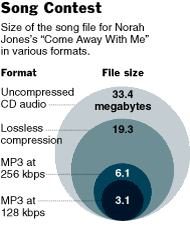 Thanks: 0
Thanks: 0
Results 1 to 2 of 2
-
 NYTimes.com: "Where’s the Other Half of Your Music File?"
NYTimes.com: "Where’s the Other Half of Your Music File?"
From NYTimes.com, info about the quality of different digital audio files available at online music stores (like iTunes). They even mentioned DVD-audio, a format I was waiting and that I never saw, and the degradation of audio quality between CDs and vinyls:
End of page one.Where’s the Other Half of Your Music File?
By WILSON ROTHMAN
Published: May 31, 2007

CHANCES are that even if you have taken the plunge and started building a digital music collection, you have never had to tangle with the word “bitrate.” That may be about to change.
The Apple iTunes store, the largest seller of music downloads, began selling tracks from EMI Music yesterday without any restrictions on copying, for a slightly higher price than usual, $1.29 instead of 99 cents. To sweeten the deal, those tracks have better sound, with a bitrate of 256 kilobits per second (kbps), up from the standard 128 kbps. Apple has gone so far as to say that this results “in audio quality indistinguishable from the original recording.”
So what exactly is a bitrate? Simply put, it is a measure of the amount of data used to represent each second of music. A higher number means that more sonic information can be used to recreate the sound. To careful listeners, or those with good audio equipment, more data can make a big difference.
Last fall, Dr. Naresh Patel, a physician in Fort Wayne, Ind., moved into a home he designed with his wife, Valerie. It has a home theater, complete with projector, surround-sound speakers and a high-end amplification system. The sonic centerpiece is two Bowers & Wilkins loudspeakers that cost Dr. Patel $12,000 “with a discount.”
It was all working beautifully until Dr. Patel connected his iPod to the system. Sitting down in the theater’s sweet spot to enjoy his music, he was instead appalled.
“I couldn’t believe what I heard,” he said. “You don’t need a trained ear to hear the complete lack of so many things: imaging, the width and the depth of the sound stage. It almost sounded monaural, like listening to music in mono. The clarity, silkiness, the musicality of the music, if you will, was not there.”
The problem was compression — the process of removing audio data to fit the music into a smaller file. Compressed audio making audiophiles crinkle their noses is not surprising, nor is it new. It has its roots in the debate of the 1980s, pitting the digital CD against the beloved analog vinyl record. The degradation of CD quality into something even more limited is simply proof to many fervent music listeners that Armageddon is indeed at hand.
But several factors are making the debate over sound quality and bitrates more relevant now. Digital storage is cheaper than ever, download speeds are increasingly fast and digital music files have taken the place of CDs in many home theaters and cars. Many people are specifically asking for higher-quality downloads, and Apple and other online retailers are eager to deliver them — for a higher price, of course. (The price of complete albums from iTunes in the higher-quality format will remain the same.)
Barney Wragg, who oversees EMI’s global digital music efforts, said there had been a shift in the music marketplace. “What was an entirely PC, MP3-player experience has changed; now people are wiring music via iPods into their stereos in their home and their car,” he said. “That’s what is driving the demand for increased fidelity. When I connect an iPod directly into the hi-fi in my car, I really notice the difference.”
Apart from bitrate, the sound quality of digital music is also affected by its format, which is determined by the software used to compress it, known as a codec. MP3 is one of the older techniques for compressing audio and is not widely used by online stores. Apple has chosen a newer format called Advanced Audio Coding (AAC), which plays on iPods and some other devices. Most other online stores use the similarly modern Windows Media Audio, or WMA, which does not play on iPods.
All three of these formats are “lossy,” meaning the encoding software surgically trims out audio information that is not easy to hear, because it is covered up by other sound or is situated at the highest and lowest ranges of human hearing. The Norah Jones track “Come Away With Me” is 33.4 megabytes when stored in an uncompressed format; the lossy compression methods bring that down to 6.1 megabytes at 256 kbps, or 3.1 megabytes at 128 kbps, regardless of the codec used. (When turning your CDs into song files on your PC, you can choose the bitrate you want in the settings of iTunes or Windows Media Player.)


jmcc's movie news: Red Dawn - RoboCop - The Witchblade - Neuromancer - ubuntu tribe - Possible Flatwoods monster movie
Flatland - Flatland: The Movie - Other users movie news: Blade Runner ---The Final Cut - I want to recommend: Perfume. The Story of a Murderer
Dayana - Stefanía

-
 Page 2 of 2
Page 2 of 2
The continuation of the previos The New York Times online article:
The End.(Page 2 of 2)
Codecs do vary in quality. Mr. Wragg of EMI said that as a rule of thumb, an MP3 at 320 kbps is roughly the same as an AAC file at 256 kbps. “The difference between WMA and AAC is more difficult to say,” he added. “Each has a slightly different way of getting compression. But in double-blind tests they perform pretty similarly — bitrate for bitrate they sound similar, but some prefer one over the other.”
Until now, online retailers have dealt in 128 Kbps tracks — most retailers, that is. Two years ago, a group of audiophiles created MusicGiants, a digital download store that specializes in “lossless” files that are compressed in a way that does not discard any audio information, resulting in tracks that average 25 megabytes in size. MusicGiants now has more than 500,000 songs from most major labels.
Scott Bahneman, chief executive of MusicGiants, said that comparing lossless tracks and compressed tracks was like comparing photos taken with a high-end digital camera and those taken with a camera phone. “Every bit counts when you’re trying to get sound quality, resolution or anything else,” he said. The site’s core audience is the type of person who spends large sums of money on home theater equipment, and wants music stored as digital files rather than on CD.
Mr. Bahneman said his company planned to offer better-than-CD-quality music in files originally created for the DVD-Audio and Super Audio CD disc formats, which did not catch on with consumers. Each song will be 250 megabytes, about the same size as one episode of a sitcom on iTunes, but without the video. These “Super HD” files will have a bitrate of up to 11,000 kbps (that is, 11 megabits per second), and will be sold by the album rather than the track, at $20 each. Mr. Bahneman said that with the latest broadband services and huge hard drives, downloading and storing high-resolution audio files should not be a big hurdle.
MusicGiants’ giant files are unlikely to appeal to the masses. Most people agree that on run-of-the-mill headphones, car speakers and compact sound systems, it is not easy to tell a low bitrate from a high one, because what is lost in compression is also lost in the reproduction of sound through those kind of speakers.
To test the effect of different bitrates, I borrowed a sound system that was not an audiophile’s wildest dream, but was certainly higher quality than the gear owned by most music buyers: a Harman Kardon AVR 147 receiver ($449) and two JBL L880 speakers ($1,400 a pair), connected to an iPod via the Harman Kardon Bridge adapter ($70).
This unscientific study involved three people (including myself) who listen to music daily in a variety of formats, from FM radio to CD. I loaded an iPod with 11 versions of “Come Away With Me,” spanning various qualities of MP3 and AAC from 64 kbps to 320 kbps, as well as one in Apple’s lossless format. Sitting in the sweet spot, we each listened to the different versions, played in random sequence, trying to determine if each subsequent version was higher or lower in quality. It was a straightforward test, and the result was surprising.
The difference between 64 and 128 kbps was stark. All three of us picked up on it. As bitrates climbed above 128 kbps, however, our guesses became increasingly haphazard; none of us could determine the difference between 320 kbps and lossless. One unexpected result was that we all thought low-bitrate AAC files sounded better than low-bitrate MP3s.
Still, even if poorer-quality tracks do not sound so terrible to all listeners, the difference between 128 kbps and 256 kbps is real. Many people will spend extra money for better-quality merchandise, perhaps in anticipation of a future sound-system upgrade. You may not buy all of your downloaded tracks a second time at higher quality, but you may decide that from now on $1.29 is a fair price to pay for an improved track.
Dr. Patel said he had mixed feelings. He said he would always prefer CD quality to compressed audio, even at 320 kbps. Will the higher-quality downloads from iTunes matter? “I’ll take the best of what I can get,” he said, “but I’m not terribly excited because it’s not that much of an improvement.”
Similar Threads
-
Looking for these songs... please help
By legolasfan411 in forum Trailer MusicReplies: 14Last Post: 05-12-2007, 08:47 PM -
Steve Jobs' "Thoughts on Music"
By jmcc in forum General Chatter - Non-Movie RelatedReplies: 2Last Post: 03-03-2007, 01:41 PM -
US tastes in music changes depending on mood of the times
By Granite in forum General Chatter - Non-Movie RelatedReplies: 0Last Post: 05-31-2005, 12:16 AM









 Reply With Quote
Reply With Quote
Bookmarks